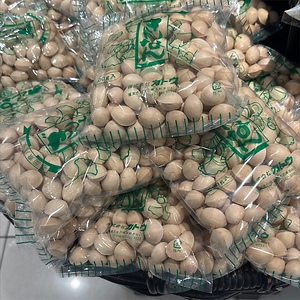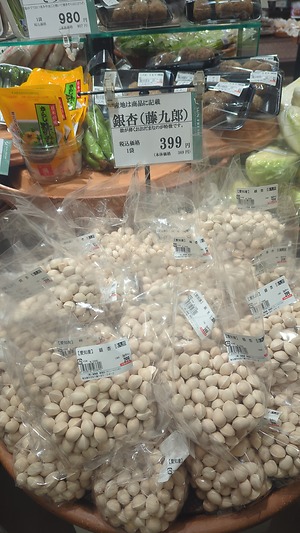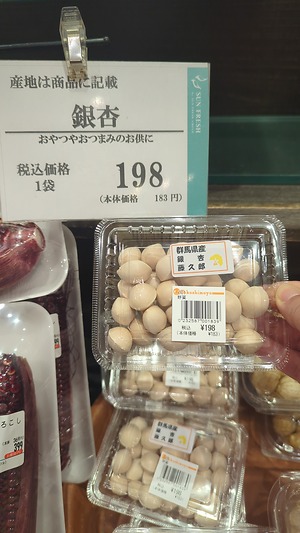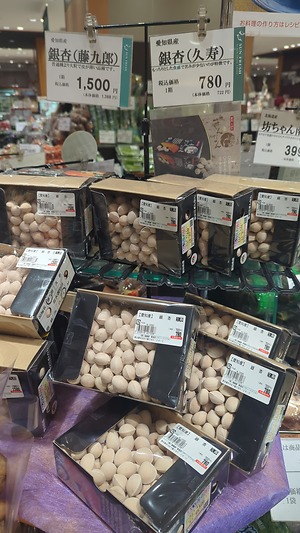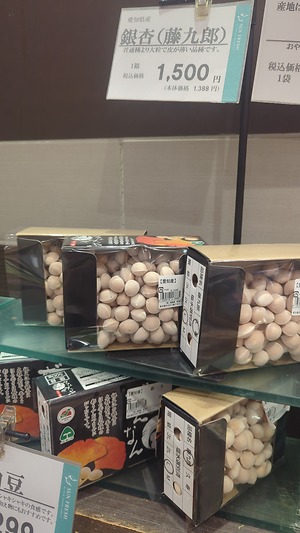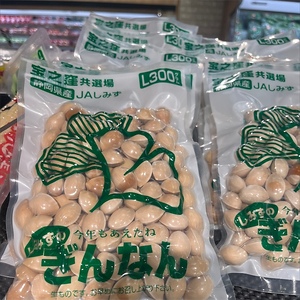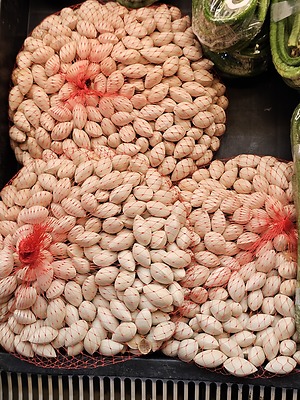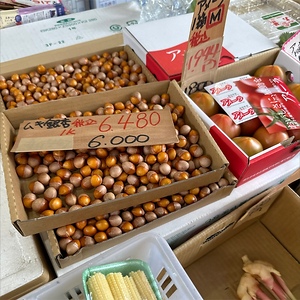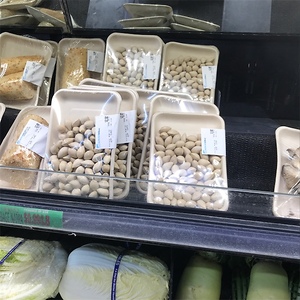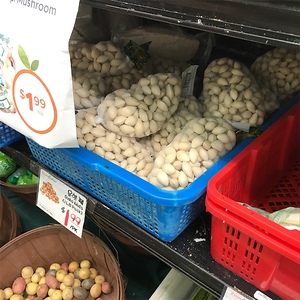

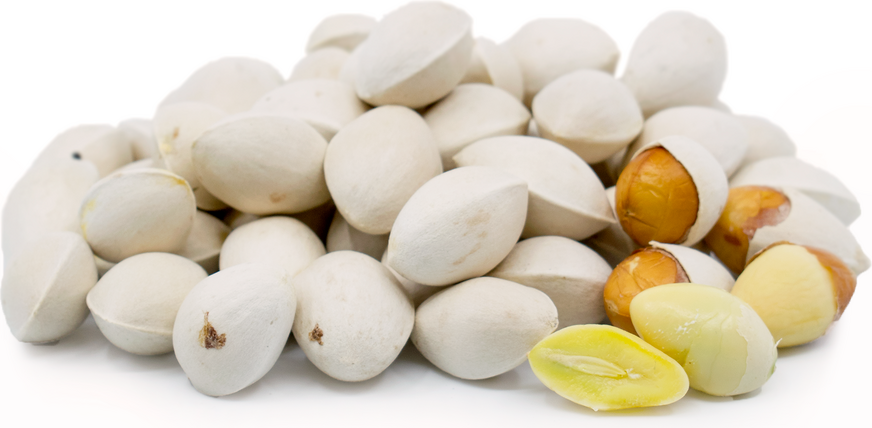
Ginkgo Nuts
Estimated Inventory, lb : 0
Description/Taste
Ginkgo nuts are a small seed encased in a hard woody shell with an oval shape and tapered, broadly pointed ends. The ivory to cream-colored shell is thinner than a pistachio shell but is still hard and tough with a smooth texture. Underneath the shell is a brown layer of skin over the nut that needs to be removed before consumption. The nut ranges in color from jade green to golden amber and has a faint translucent nature. Once cooked, the nuts have a dense and chewy texture reminiscent of chestnuts, edamame, or potatoes. Ginkgo nuts release an offensive, pungent odor when fresh off the tree. Fresh Ginkgo nuts contain an outer fleshy layer with an aroma that smells like a blend of vomit, rancid butter, or rotten Camembert cheese. Once the flesh is removed, the seed extracted, and the nut cooked, the odor dissipates. Cooked Ginkgo nuts have a subtly sweet to bitter flavor with a neutral, nutty taste.
Seasons/Availability
Ginkgo nuts are available in the fall, with a peak season in September through November.
Current Facts
Ginkgo nuts, botanically classified as Ginkgo biloba, are the seeds of the Ginkgo tree belonging to the Ginkgoaceae family. The deciduous trees are native to Asia and are an ancient species that grows wild and has been cultivated for centuries as an ornamental. Female trees only produce ginkgo nuts, and it takes over twenty years for a Ginkgo tree to begin bearing fruits. The fruits are small and showcase a thin, fleshy layer surrounding the hard shell encasing the nut. This flesh contains toxic compounds that may cause irritations, producing blisters on the skin. Gloves must be worn when harvesting Ginkgo fruits directly from the tree, and once the seeds are extracted, they are packaged and sold for culinary use. Ginkgo nuts are known as Ginnan in Japan and Bai Guo in China and are a popular snack for their chewy texture and nutty, bittersweet flavor.
Nutritional Value
Ginkgo nuts are a source of potassium to balance fluid levels within the body, vitamin C to strengthen the immune system, calcium and phosphorus to build strong bones and teeth, and other nutrients, including magnesium, iron, zinc, manganese, copper, and thiamin. The nuts are also used in eastern folk medicines to loosen phlegm in the chest and reduce the severity of coughs. It is vital to mention that Ginkgo nuts contain MPN, or 4'-methoxypyridoxine, a chemical toxin that is poisonous if consumed in large quantities.
Applications
Ginkgo nuts are toxic when raw and must be cooked before consumption. The nuts should also be eaten in small quantities, as excess amounts may cause poisoning. The hard shells can be removed by cracking them open with a rolling pin, nutcracker, or hammer, or they can be fried in a pan to pop open the shells. Once the shells are removed, Ginkgo nuts are typically blanched and then fried, roasted, or boiled. The nuts add flavor to steamed rice, can be simmered into soups and stews, grilled on skewers, or added to stir-fries. They can also be mixed into dessert soups and incorporated into sweet preparations. Ginkgo nuts are often added to congee or served with pickled lotus root and mushrooms in China. In Japan, Ginkgo nuts are used in chawanmushi, a savory egg custard, and dobin mushi, a steamed soup. The nuts are also customary ingredients in celebratory dishes in Japan, including recipes for weddings, birthdays, and new year's. Ginkgo nuts pair well with broccoli, carrots, mushrooms, lotus root, sauces including soy sauce, sesame oil, miso, and vinegar, seafood, and meats such as beef, poultry, and pork. Whole, uncooked Ginkgo nuts will keep 1 to 2 weeks when stored in the refrigerator. Once the nuts are cooked, they will keep for a few days to a week in a plastic bag in the fridge.
Ethnic/Cultural Info
Ginkgo trees are revered in Japan, often worshipped as the "tree of fire prevention" and "savior tree." Legend has it that a Ginkgo tree protected a temple and dozens of helpless people who were being surrounded by fire. As the flames were about to consume the temple, a Ginkgo tree began spewing water to push back the fire and saved the filled temple. The water myths surrounding Ginkgo trees continued throughout history, with stories of Ginkgo trees spouting water during air raids and earthquake fires. These stories led Ginkgo trees to be worshipped as forms of deities, and the trees were often planted near temples. Beyond mythology, Ginkgo trees were the first plants to grow in the land decimated by the 1945 atomic bomb in Hiroshima.
Geography/History
Ginkgo nuts are found on Ginkgo trees, a species native to Asia, specifically in regions throughout China. The trees are one of the oldest species on Earth, regarded by experts as living fossils, and can be traced back millions of years. Ginkgo trees almost went extinct during the Ice Age, and many western scientists assumed the tree was extinct until they rediscovered it in the 1600s in Japan. Despite the western world's lack of awareness regarding Ginkgo trees, a group of Buddhist monks in China spent years protecting and cultivating the species. Ginkgo trees remained prominent in Asia throughout history and were introduced to Japan from China sometime in the 15th or 16th centuries. Ginkgo trees were also planted in Europe in the early 18th century and were carried to North America through William Hamilton in 1785. The oldest known Ginkgo tree is found in the Di Lin Temple in the Fu Lai Mountains in the Shangdong province in China and is believed to be more than 3,500 years old. Today Ginkgo nuts are produced in the Oita, Fukuoka, and Aichi Prefectures in Japan, with the largest volume produced in Aichi. The nuts are also widely cultivated and sold in China and Korea through street hawkers, local markets, and select grocers.
Recipe Ideas
Recipes that include Ginkgo Nuts. One



